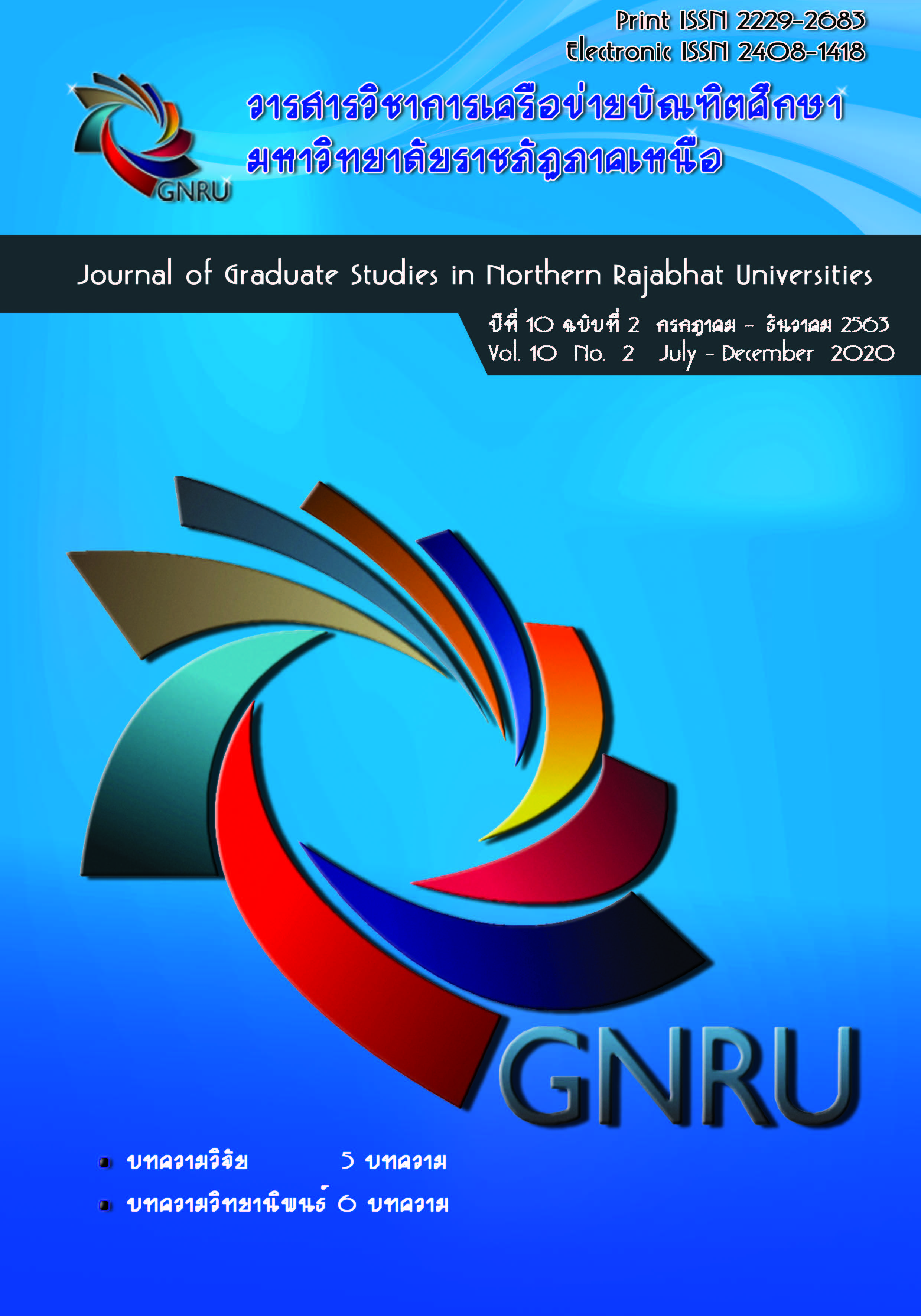การบริหารจัดการหนี้สินครัวเรือนแบบมีส่วนร่วมจังหวัดลำปาง Integrated Participatory Community Debts Management Lampang Province
Main Article Content
Abstract
การวิจัยนี้มีวัตถุประสงค์คือ 1.เพื่อวิเคราะห์ปัญหาและปัจจัยสาเหตุที่ก่อภาวะหนี้สินครัวเรือน 2. เพื่อสร้างกระบวนการเรียนรู้การบริหารจัดการหนี้สินครัวเรือนแบบมีส่วนร่วมของชุมชน และ 3. เพื่อสร้างความเข้มแข็งเศรษฐกิจระดับครัวเรือนให้เกิดความมั่นคง การวิจัยนี้เป็นวิจัยเชิงคุณภาพ ผู้ให้ข้อมูลสำคัญได้แก่ ผู้นำ ชาวบ้านและสมาชิกกองทุน ชุมชนละ 50 คนโดยคัดเลือกแบบเจาะจงจาก 4 ชุมชน คือ ชุมชนรถไฟ, ชุมชนหนองห้า, ชุมชนแม่ปุง และชุมชนแม่ตานน้อย เครื่องมือที่ใช้วิจัย คือ แบบเก็บข้อมูลครัวเรือน แบบสัมภาษณ์ และแบบบันทึกการสนทนากลุ่ม วิเคราะห์ข้อมูลโดยใช้เทคนิคการวิเคราะห์เชิงเนื้อหา
ผลวิจัยพบว่า ปัญหาหนี้สินเกิดจากค่าใช้จ่ายการศึกษาของบุตร ใช้เงินไม่เป็นไปตามวัตถุประสงค์ และหนี้สินที่เกิดจากการอุปโภคบริโภคในชีวิตประจำวัน การซื้อหวยใต้ดิน และการฟุ่มเฟือย การกู้ที่มีอัตราดอกเบี้ยเงินกู้สูง ผลจากการเรียนรู้การบริหารจัดการหนี้สินครัวเรือน พบว่า กิจกรรมการบันทึกบัญชีรับจ่ายทำให้ชุมชนเกิดความตระหนกต่อค่าใช้จ่ายที่มีจำนวนมาก และทำให้เกิดความตระหนักถึงผลกระทบต่าง ๆของหนี้สิน และตื่นตัวแก้ปัญหาด้วยการพึ่งพาตนเอง ตามแผนกิจกรรมการแก้ไขปัญหาหนี้สินทั้ง 4 ชุมชน ทำให้ลดค่าใช้จ่ายที่ไม่จำเป็น ประหยัดอดออมเพิ่มขึ้น และสร้างอาชีพเสริมที่เหมาะสมตามบริบทของชุมชน
ผลประเมินการสร้างความเข้มแข็งทางเศรษฐกิจ พบว่า ชุมชนหนองห้า ทำบัญชีครัวเรือนขยายผล ทำให้ชุมชนเห็นประโยชน์ ทำให้ลดรายจ่ายที่ไม่จำเป็นและมีเงินออมเพิ่มขึ้น, ชุมชนแม่ปุง ทำกองทุนขยะฮอมบุญเพื่อสร้างรายได้ และนำไปสู่การจัดทำระบบสวัสดิการชุมชน และทำให้เกิดทัศนคติที่มอง "คุณค่า" มากกว่าเรื่อง มูลค่า หรือกำไร, ชุมชนแม่ตานน้อย ทำการอนุรักษ์ป่าต้นน้ำ พบว่า สิ่งที่ขาดหายไปคือ แนวทางการส่งเสริมและพัฒนาการท่องเที่ยวที่ชัดเจน ขณะที่กิจกรรมการปลูกผักอินทรีย์ กลับสามารถสร้างรายได้แก่ครัวเรือน, ชุมชนรถไฟทำตลาดร้อยปีนครลำปาง เพื่อสร้างรายได้ชุมชน พบว่า การดำเนินงาน ขาดความร่วมมือและการสนับสนุนจากหน่วยงานที่เกี่ยวข้อง ผลประเมินได้ข้อสรุปคือ ชุมชนควรให้ความสำคัญต่อการลดรายจ่ายในครัวเรือน และตามด้วยการสร้างรายได้ที่เหมาะสม เพื่อเป็นภูมิคุ้มกันให้แก่ครอบครัวและเกิดการพัฒนาที่สมดุล
The purposes of this research were to 1) analyze problems and causal factors creating household debts 2) create a participatory learning process for household debts management of the community and 3) create household level economic strength for stability. This research is a qualitative research and important respondents were leaders, villagers and fund members totaled 200 persons purposefully selected from 4 communities: Rot fai community, Nong haa community, Mae pung community and Mae taan noicommunity. The research tools were tcnap, interviews and focus groups and data were analyzed using the contents analysis technique.
The research findings revealed debt problem coming from children educational expenses, using loan money not according to the stated loan purposes and debts from daily-life consumption. Buying underground lottery and extravagance made high interest loans. Results from household debt management learning account recording activity made the community startled at the high expenses and realized the effects of debts and awake to solve the problem by self-reliance. The debt problem solving plan in the 4 communities reduced unnecessary expenses, increased savings and created suitable supplementary occupations according to the community roles.
The assessment of economic strength creation found that Nong haa community practiced extended household account that made the community see the benefits, reduced unnecessary expenses and had increased household savings. Mae pung community made trash collection fund and found the results of the activity leading to the creation of community welfare system and the attitude of looking at the ‘value’ more than cost and profit. Mae taan noi community conserved the water shade forest stream and found that the missing thing was a clear way to promote and develop tourism while organic vegetable planting created incomes for the households. Rot fai community operated the Nakhon Lampang 100 Year Old Market to support community incomes but found that the operations lacked cooperation and support from other concerned agencies. Results of assessment concluded that the community should place the importance of household expense reduction follow by creating appropriate incomes to become immunity for the families and balanced developments.
Article Details
References
Andrew Cox and Eddy Verbaa. (2018). Exploring Research Data Management (RDM). quoted in Juthathip Chanlun. Journal Faculty of Arts, Silpakorn University, 62(1).
Chanthana Srithongkum, et al. (2015). The process of managing household debt through participation of children and youth Huai Yab Village, Village No. 5, Tha Nuea Sub-district, Mae On District, Chiang Mai Province: Office of the Research Fund (TRF). Bangkok.
Khanitta Nuntaboot, et al. (2018). A Guidebook for Thailand Community Network Appraisal Program. (1st ed.). Bangkok: Thai Health Promotion Foundation, Healthy Community Strengthening Section.
Marquardt, M. J. (2011). Development of learning bodies. Translated from Building the Learning Organization: Achieving Strategic.Advantage Through a Commitment to Learning. (3rd ed.). By Kan Sudamak Siriranon. (2014). Bangkok: ExportsNet.
Manit Singthongchai. (2014). Management of household debt in accordance with the organic agriculture guidelines of community enterprise groups. Pa O Sub-district, Lan Sak District, Uthai Thani Province. 4th Sustainable Rural Development Conference 2014 "Rethink: Social Development for Sustainability in ASEAN Community "11-13 June, 2014, Nakhon Sawan Rajabhat University.
Napaphorn Likitwongkajorn. (2007). Household Accounting: Tools to Sufficiency Economy. Khon Kaen: Faculty of Management Science, Khon Kaen University.
Ornsri Ngamwittayaphong. (2004). Paradigm and Rural Poverty Management of the State During the economic and social development plan National Edition 1-8: 1961-2001. Thammasat University, Bangkok.
Phra Suthi Rattanabundit (Sutit Un-un), (2018). List Model For Research And Social Development. Printed by Buddhist Research Institute, Mahachulalongkornrajavidyalaya University: Phra Nakhon Si Ayutthaya Province.
Thaipat Institute. (2007). Royal speech, King Bhumibol Adulyadej Maha Bhumibol Adulyadej the Great, on the occasion of the celebration Royal Birthday 4 December, 1999. Retrieved from https://faq.sufficiencyeconomy.com/2007/03/blog-post.html
Saithong Lertpian. (2014). Personal financial planning behavior of accounting students. Faculty of Business Administration, Lampang Commercial and Technology School. Journal of Academic Network of Rajabhat University North. 4(6): 21-23.
Saras Chuenchoksan, and others. (2019). Thai household debt: facts from BOT-Nielsen Household. Financial Survey. FAQ Issue 143 Bank of Thailand.
Silaporn Buasai. (2006). Sufficiency economy, join in learning, expand network. The Office of Research Fund, Bangkok: Amarin.
Sirirat Chensirisak. (2011). Management of the project to solve the problem of public debt in the perspective of farmers: A case study of the northeast region. KKU Research Journal, 16(3).
Supit Suwannik. (2018, October 2).Where should a sustainable solution to the Thai household debt problem begins? bangkokbiznews, Retrieved August 25, 2020, from http://www.thairath.co.th/content/621428
Thais in debt, inadequate debt, inadequate debt, low income, high expenses. (May 17, 2016). Thairath Online, printed version,. Retrieved July 18, 2017, from http://www.thairath.co.th/content/621428. Yanyong Loeschavangkul et al., (2018, 8 August). focus groups.


